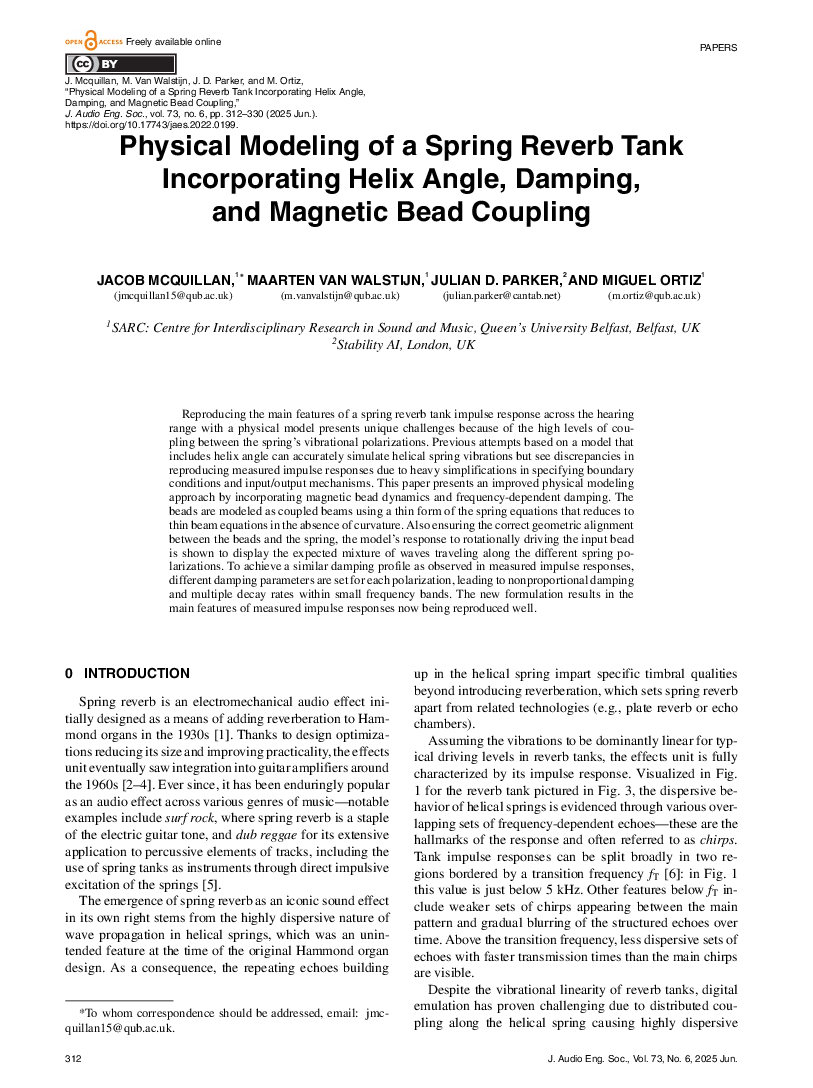Home / Publications / E-library page
You are currently logged in as an
Institutional Subscriber.
If you would like to logout,
please click on the button below.
Home / Publications / E-library page
Only AES members and Institutional Journal Subscribers can download
Reproducing the main features of a spring reverb tank impulse response across the hearing range with a physical model presents unique challenges because of the high levels of coupling between the spring’s vibrational polarizations. Previous attempts based on a model that includes helix angle can accurately simulate helical spring vibrations but see discrepancies in reproducing measured impulse responses due to heavy simplifications in specifying boundary conditions and input/output mechanisms. This paper presents an improved physical modeling approach by incorporating magnetic bead dynamics and frequency-dependent damping. The beads are modeled as coupled beams using a thin form of the spring equations that reduces to thin beam equations in the absence of curvature. Also ensuring the correct geometric alignment between the beads and the spring, the model’s response to rotationally driving the input bead is shown to display the expected mixture of waves traveling along the different spring polarizations. To achieve a similar damping profile as observed in measured impulse responses, different damping parameters are set for each polarization, leading to nonproportional damping and multiple decay rates within small frequency bands. The new formulation results in the main features of measured impulse responses now being reproduced well.
Author (s): Mcquillan, Jacob; van Walstijn, Maarten; Parker, Julian; Ortiz, Miguel
Affiliation:
SARC: Centre for Interdisciplinary Research in Sound and Music, Queen’s University Belfast, Belfast, UK; SARC: Centre for Interdisciplinary Research in Sound and Music, Queen’s University Belfast, Belfast, UK; SARC: Centre for Interdisciplinary Research in Sound and Music, Queen’s University Belfast, Belfast, UK; Stability AI, London, UK
(See document for exact affiliation information.)
Publication Date:
2025-06-04
Import into BibTeX
Permalink: https://aes2.org/publications/elibrary-page/?id=22915
(1409KB)
Click to purchase paper as a non-member or login as an AES member. If your company or school subscribes to the E-Library then switch to the institutional version. If you are not an AES member Join the AES. If you need to check your member status, login to the Member Portal.

Mcquillan, Jacob; van Walstijn, Maarten; Parker, Julian; Ortiz, Miguel; 2025; Physical Modeling of a Spring Reverb Tank Incorporating Helix Angle, Damping, and Magnetic Bead Coupling [PDF]; SARC: Centre for Interdisciplinary Research in Sound and Music, Queen’s University Belfast, Belfast, UK; SARC: Centre for Interdisciplinary Research in Sound and Music, Queen’s University Belfast, Belfast, UK; SARC: Centre for Interdisciplinary Research in Sound and Music, Queen’s University Belfast, Belfast, UK; Stability AI, London, UK; Paper ; Available from: https://aes2.org/publications/elibrary-page/?id=22915
Mcquillan, Jacob; van Walstijn, Maarten; Parker, Julian; Ortiz, Miguel; Physical Modeling of a Spring Reverb Tank Incorporating Helix Angle, Damping, and Magnetic Bead Coupling [PDF]; SARC: Centre for Interdisciplinary Research in Sound and Music, Queen’s University Belfast, Belfast, UK; SARC: Centre for Interdisciplinary Research in Sound and Music, Queen’s University Belfast, Belfast, UK; SARC: Centre for Interdisciplinary Research in Sound and Music, Queen’s University Belfast, Belfast, UK; Stability AI, London, UK; Paper ; 2025 Available: https://aes2.org/publications/elibrary-page/?id=22915
@article{mcquillan2025physical,
author={mcquillan jacob and van walstijn maarten and parker julian and ortiz miguel},
journal={journal of the audio engineering society},
title={physical modeling of a spring reverb tank incorporating helix angle, damping, and magnetic bead coupling},
year={2025},
volume={73},
issue={6},
pages={312-330},
month={november},}
TY – paper
TI – Physical Modeling of a Spring Reverb Tank Incorporating Helix Angle, Damping, and Magnetic Bead Coupling
SP – 312 EP – 330
AU – Mcquillan, Jacob
AU – van Walstijn, Maarten
AU – Parker, Julian
AU – Ortiz, Miguel
PY – 2025
JO – Journal of the Audio Engineering Society
VO – 73
IS – 6
Y1 – November 2025